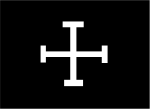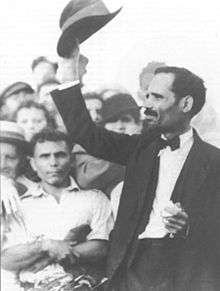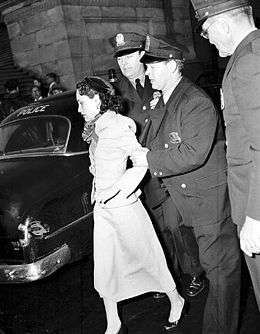United States Capitol shooting incident (1954)
| U.S. Capitol shooting incident (1954) | |
|---|---|
| Location | Washington, D.C. |
| Date | March 1, 1954 |
| Target | United States Capitol (chamber of the House of Representatives) |
Attack type | Shooting |
| Weapons | Machine pistols |
| Deaths | 0 |
Non-fatal injuries | 5 (Alvin M. Bentley, Clifford Davis, Ben F. Jensen, George Hyde Fallon, and Kenneth A. Roberts) |
| Perpetrators | Lolita Lebrón, Rafael Cancel Miranda, Andrés Figueroa Cordero, and Irving Flores Rodríguez |
| Motive | Puerto Rican independence movement |
| Part of a series on the |
| Puerto Rican Nationalist Party |
|---|
 Flag of the Puerto Rican Nationalist Party |
|
Nationalist leaders
|
The United States Capitol shooting incident of 1954 was an attack on March 1, 1954, by four Puerto Rican nationalists; they shot 30 rounds from semi-automatic pistols from the Ladies' Gallery (a balcony for visitors) of the House of Representatives chamber in the United States Capitol. They wanted to highlight their desire for Puerto Rican independence from US rule.
The nationalists, identified as Lolita Lebrón, Rafael Cancel Miranda, Andres Figueroa Cordero, and Irving Flores Rodríguez, unfurled a Puerto Rican flag and began shooting at the 240 Representatives of the 83rd Congress, who were debating an immigration bill. Five Representatives were wounded, one seriously, but all recovered. The assailants were arrested, tried and convicted in federal court, and given long sentences, effectively life imprisonment. In 1978 and 1979, they were pardoned by President Jimmy Carter; all four returned to Puerto Rico.
Background
Independence movement in Puerto Rico
The Puerto Rican Nationalist Party was founded in September 17, 1922 by people seeking independence. They contended that, as a matter of international law, the Treaty of Paris could not empower the Spanish to "give" what was no longer theirs.[1] While the Nationalists and other political parties supported independence, some political parties supported autonomy for the island within a formal relationship with the United States.
During this period of unrest, the electorate increasingly voted for the People's Democratic Party (PPD), which by 1940 controlled a majority in the legislature. It supported the act of 1950 by the US Congress, which established Puerto Rico as a Estado Libre Asociado ("Free Associated State"), with some autonomy. The people could elect their own governor, who was of the PPD; a bicameral legislature was established, and executive functions similar to those of American states were developed. The US retained responsibility for defense and foreign treaties.
Puerto Rican Nationalist Party response
The Puerto Rican Nationalist Party Revolts of the 1950s were a widespread call for independence against this colonial regime. The party demanded the recognition of the 1898 Charter of Autonomy, and Puerto Rico's international sovereignty. It also repudiated the status of Estado Libre Asociado, established in 1950 by law, as continued colonialism.
|
|
The Nationalist president, Pedro Albizu Campos, ordered armed uprisings on October 30, 1950, in several towns, including Peñuelas, Mayagüez, Naranjito, Arecibo and Ponce. The most notable uprisings occurred in Utuado, Jayuya, and San Juan. They were suppressed by Puerto Rican forces, assisted by US forces.
In Utuado, police killed the insurgents after they attacked the station. In Jayuya, insurgents declared the "Free Republic of Puerto Rico" after taking control of the police station; they held the city for three days, until the U.S. sent bomber planes, artillery, Puerto Rican National Guard and Army troops to suppress the revolt. In San Juan, the Nationalists attacked the governor's residence, intending to assassinate the governor, Luis Muñoz Marín, but were unsuccessful.

The revolts resulted in many casualties: of the 28 dead, 16 were Nationalists, 7 were police officers, 1 a National Guardsman, and 4 were uninvolved civilians. Of the 49 wounded, of 23 were police officers, 6 were National guardsmen, 9 were Nationalists, and 11 were uninvolved civilians.[2]
The actions were not limited to Puerto Rico. Two Puerto Rican Nationalists, who were living in New York City at the time, planned to assassinate the US President, Harry S. Truman. On November 1, 1950, they attacked police and Secret Service to gain access to Blair House in Washington, D.C., where Truman was staying during major renovations of the White House. One Nationalist, Griselio Torresola, was killed in the attack, as was a White House police officer, Leslie Coffelt. The other, Oscar Collazo, was tried and convicted, and sentenced to prison.[3]
Acknowledging the importance of the question of Puerto Rico's status, Truman supported a plebiscite in Puerto Rico in 1952 on the new constitution to determine its relationship to the U.S.[4] The people voted by nearly 82% in favor of the new constitution and Free Associated State, or Commonwealth.[5]
Attack preparations

Nationalists were not satisfied with the people's vote in the 1952 plebiscite. In the early 1950s, Don Pedro Albizu Campos, president of the Puerto Rican Nationalist Party, had been corresponding from his prison with 34-year-old Lolita Lebrón. Some of this correspondence discussed the Nationalist Party revolts of 1950. It also discussed Puerto Rican Governor Luis Muñoz Marín, who had succeeded in having Puerto Rico declared an Estado Libre Asociado (Free Associated State) of the U.S.
In 1954, a group of Nationalists, which included Lebrón, Rafael Cancel Miranda, Irving Flores and Andrés Figueroa Cordero, decided to focus the world's attention on Puerto Rico's status, which they considered as a colony of the U.S. They planned to attack multiple locations in Washington, D.C. with force.[6]
Albizu Campos did not order this attack, but the Nationalists continued to plan for it. Lebrón decided to lead the group and, eventually, the attack.[6] Lebrón concluded that a single attack on the House of Representatives had a greater prospect for success than trying to attack multiple targets.[7] They chose the date of March 1, 1954, to coincide with the opening of the Conferencia Interamericana (Interamerican Conference) in Caracas.[6] Lebrón intended to call attention to Puerto Rico's independence cause, particularly among the Latin American countries at the conference.
The attack
|
|
On the morning of March 1, Lebrón traveled to Grand Central Terminal in Manhattan, where she rendezvoused with the rest of the group. They took the train to Washington, DC, and went the short distance from Union Station to the Capitol. Rafael Cancel Miranda suggested they postpone the attack, as it was late and the weather was rainy.[8] Lebrón said, "I am alone" and continued towards the Capitol building's interior. The group looked at each other, and decided to follow her.
When Lebrón's group reached the visitor's gallery above the House chamber, they sat while the representatives discussed the Mexican economy and issues of immigration. After Lebrón gave the order, the group quickly recited the Lord's Prayer. She stood up and shouted, "¡Viva Puerto Rico Libre!" (Long live a Free Puerto Rico!) and unfurled the flag of Puerto Rico.[9] The group opened fire with semi-automatic pistols directed toward the Representatives below.[10]
Five representatives were shot in the attack. The wounded lawmakers were Alvin M. Bentley (R-Michigan), who took a bullet to the chest, Clifford Davis (D-Tennessee), who was shot in the leg, Ben F. Jensen (R-Iowa), who was shot in the back, as well as George Hyde Fallon (D-Maryland) and Kenneth A. Roberts (D-Alabama). House pages helped carry Alvin Bentley off the House floor.[11] The representatives were treated and recovered.
Lebrón said she fired her shots at the ceiling, while Figueroa's pistol jammed. Some 30 shots were fired (mostly by Cancel, according to his account), wounding five lawmakers; one representative, Alvin Bentley from Michigan, was seriously wounded in the chest.[12] Upon being arrested, Lebrón yelled, "I did not come to kill anyone, I came to die for Puerto Rico!"
Aftermath and arrests

The Nationalists were immediately arrested in Washington, D.C. The next morning in Puerto Rico, the Insular Police attacked the home of Pedro Albizu Campos, president of the Nationalist Party, with guns and tear gas. Under the command of the Chief of Police of Puerto Rico, Salvador T. Roig, they fired into Campos' home from the roof of a Pentecostal Church and from a boarding house which faced the home. They arrested Campos and took him to jail. He was unconscious and half-asphyxiated when taken from the house.[13]
Police Chief Roig later said that the order to arrest Albizu Campos "did not make any sense." Albizu Campos's phones were tapped, his mail was being intercepted, and Albizu was under 24-hour surveillance by the FBI, the CIA and the Insular Police.[13] The FBI reports on Albizu Campos and the Puerto Rican Nationalist Party ultimately exceeded over one million pages in length.[14] They found no evidence that Albizu was directly connected with the attack on U.S. congress.[13]
The Governor of Puerto Rico, Luis Muñoz Marín, revoked Albizu's pardon, and had the political leader returned to La Princesa prison, from which he had been released only six months before. He was accused of sedition, violation of Puerto Rico Law 53 of 1948 (otherwise known as the "Gag Law") and the attempted violent overthrow of the U.S. government.[13] Two years later, on March 25, 1956, Albizu Campos suffered an embolism and a stroke while in prison, leaving him semi-paralyzed and mute. He was not released from U.S. federal custody for another nine years, shortly before his death, which occurred on April 21, 1965.[15]
Trial and imprisonment
Lebrón, Cancel Miranda and the other defendants were charged in federal court with attempted murder and other crimes. The trial began on June 4, 1954, with federal Judge Alexander Holtzoff presiding over the case, under strict security measures. A jury composed of seven men and five women was assembled; their identities were kept secret. The prosecution was led by Leo A. Rover; 33 witnesses testified.[16]
Ruth Mary Reynolds and the organization which she founded, the American League for Puerto Rico's Independence, secured lawyers for Lebrón and the other three co-defendants.[17] The accused were the only ones to testify in their defense. Lebrón reaffirmed that she came "to die for the liberty of her homeland."[18][19]
On June 16, 1954, the jury declared the four guilty. The prosecutor demanded the death penalty but Judge Holtzoff decided on 70 years' imprisonment for each. Given the age of the accused, this meant imprisonment for life.[20][21]
American League lawyers appealed the sentence. On July 13, 1954, the four defendants were taken to New York, where they appeared before federal Judge Lawrence E. Walsh of the Second Circuit Court of Appeals. They declared themselves not guilty on the charge of "trying to overthrow the government of the United States," but remained firm in demanding independence for Puerto Rico.[22] Among the prosecution's witnesses was Gonzalo Lebrón Jr., who testified against his sister.
On October 26, 1954, Judge Walsh found all of the defendants guilty of conspiracy, and sentenced them to six additional years in prison, for a total of 76 years each. Cancel Miranda, considered to be the primary shooter, received a prison sentence of 85 years.[23]
The four were sent to different prisons: Figueroa Cordero to the federal penitentiary in Atlanta; Lebrón to the women's prison in Alderson, West Virginia; and Flores Rodriguez to Leavenworth, Kansas, where Oscar Collazo was incarcerated following his involvement in the attempted assassination of President Harry S Truman in 1950. Cancel Miranda was sent to Alcatraz, in the center of San Francisco Bay.[23]
Release
Figueroa Cordero was released in 1978. One year later, in 1979, President Jimmy Carter pardoned the remaining Nationalists. Some analysts said this was in exchange for Fidel Castro's release of several American CIA agents being held in Cuba on espionage charges, but the US said that was not the case.[17] The Nationalists were received in Puerto Rico with a heroes' welcome from roughly 5,000 people at San Juan International Airport.[24]
Further reading
- "War Against All Puerto Ricans: Revolution and Terror in America’s Colony"; Author: Nelson Antonio Denis; Publisher: Nation Books (April 7, 2015); ISBN 978-1568585017.
See also
- José S. Alegría
- Casimiro Berenguer
- Puerto Rican Independence Party
- United States Capitol shooting incident (1998)
- United States Capitol shooting incident (2013)
References
- ↑ Ribes Tovar et al., pp. 108–112.
- ↑ PEDRO A. MALAVET, SEMINAR: THE U.S. TERRITORIAL POSSESSIONS; SPRING 2006, University of Florida.
- ↑ American Gunfight: The Plot To Kill Harry Truman - And The Shoot-Out That Stopped It. Simon & Schuster (2005), ISBN 0-7432-6068-6.
- ↑ Hunter, Stephen; Bainbridge, Jr., John (2005). American Gunfight: The Plot To Kill Harry Truman – And The Shoot-Out That Stopped It. New York: Simon & Schuster. pp. 4, 251. ISBN 978-0-7432-6068-8.
- ↑ Nohlen, D (2005) Elections in the Americas: A Data Handbook, Volume I, p. 556, ISBN 9780199283576.
- 1 2 3 Ribes Tovar et al., p. 132.
- ↑ Ribes Tovar et al., p. 134.
- ↑ Ribes Tovar et al., p. 136.
- ↑ "No one expected attack on Congress in 1954". Holland Sentinel. Associated Press. 2004-02-29. Archived from the original on 2005-03-22. Retrieved 2008-09-19.
- ↑ Edward F. Ryan, The Washington Post, March 2, 1954, pp. 1, 12–13.
- ↑ Michael Barone and Grant Ujifusa (1993). The Almanac of American Politics 1994. Washington, D.C.: National Journal. p. 749. ISBN 0-89234-057-6.
- ↑ Clayton Knowless (1954-03-02). Five Congressmen Shot in House by 3 Puerto Rican Nationalists; Bullets Spray from Gallery. The New York Times. p. 1.
- 1 2 3 4 Federico Ribes Tovar, Albizu Campos: Puerto Rican Revolutionary, pp. 141–144.
- ↑ "FBI Files"; "Puerto Rico Nationalist Party"; SJ 100-3; Vol. 23; pp. 104–134.
- ↑ Tovar (20xx), Albizu Campos, pp. 159–168.
- ↑ Ribes Tovar et al., p. 178.
- 1 2 "Guide to the Ruth M. Reynolds Papers 1915-1989", Centro Puerto Rico.
- ↑ Ribes Tovar et al., p. 186.
- ↑ Ribes Tovar et al., p. 188.
- ↑ Ribes Tovar et al., pp. 193–194.
- ↑ Rockwell, Lew (2011-01-12) "How Safe Is It To Be a Congressman?", LewRockwell.com.
- ↑ Ribes Tovar et al., p. 197.
- 1 2 Ribes Tovar et al., p. 209.
- ↑ Nation: "We Have Nothing to Repent", TIME.
External links
- Biographies from the Biographical Directory of the United States Congress:
- BENTLEY, Alvin Morell (1918-1969)
- DAVIS, Clifford (1897-1970)
- FALLON, George Hyde (1902-1980)
- JENSEN, Benton Franklin (1892-1970)
- ROBERTS, Kenneth Allison (1912-1989)